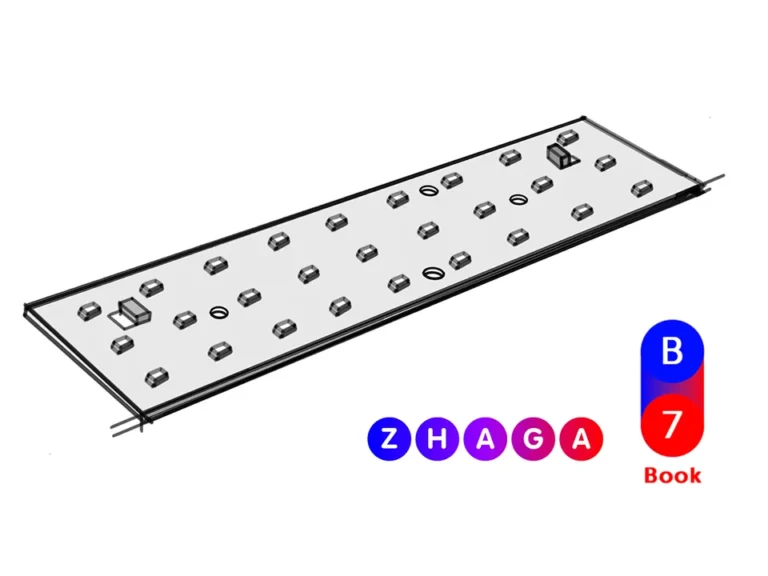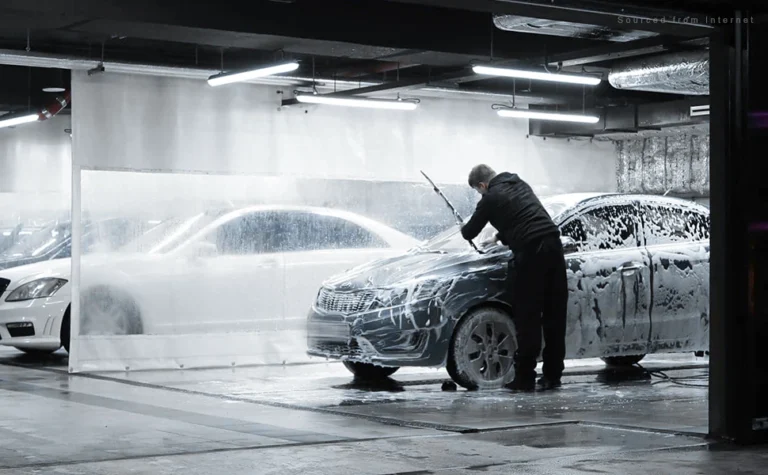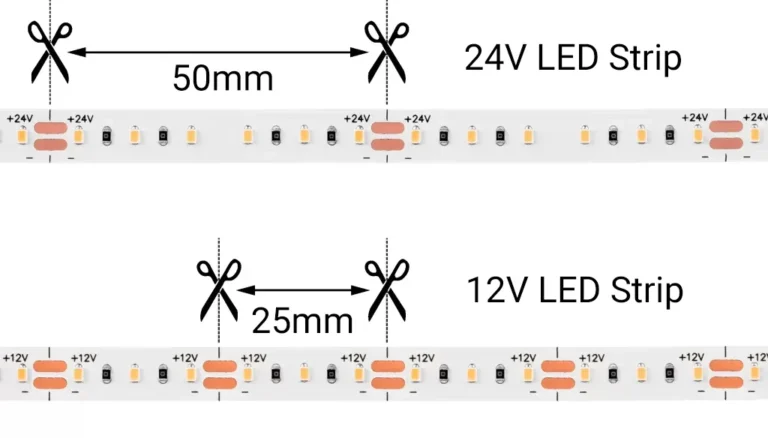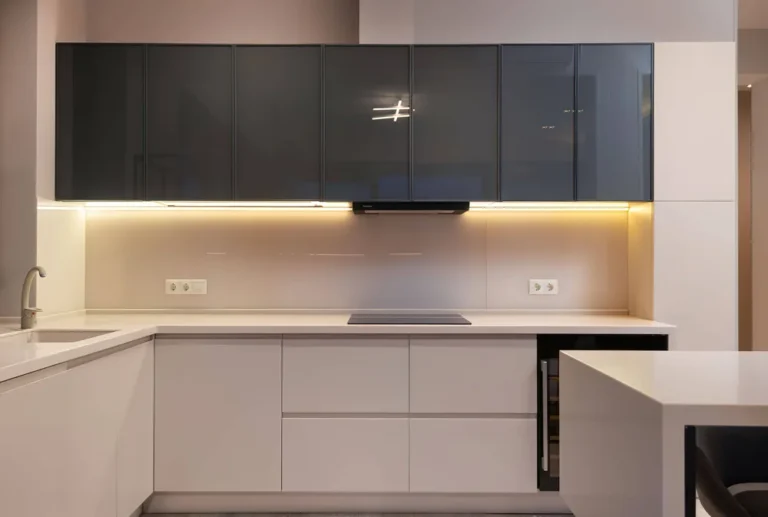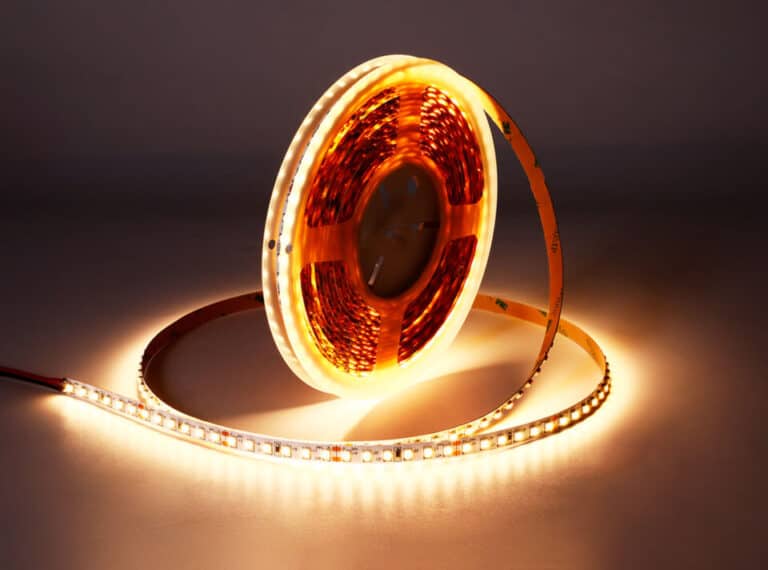実際の照明プロジェクト、モデル ルームの建設、または現場での設置では、12V LED ストリップが 24V 電源に接続されていないため、電源構成が不安定なため、珍しくありません。 これは単純な「電圧の不一致」のように思えるかもしれませんが、LED の焼損、過熱と喫煙、製品の故障、さらにはプロジェクトの遅延などの深刻な問題につながる可能性があります。
LED ストリップ インテグレーター、建築照明請負業者、卸売業者にとって、システム全体を置き換えずに技術的な代替ソリューションを見つけることが重要になっています。
この記事は、体系的に分析します。
- 動作原理と電圧不一致のリスク
- 24V システムでの 12V LED ストリップのアプリケーション制限
- 実現可能な電圧削減および分離ソリューション
- プロジェクトのシナリオに基づいて安全な電源設計を選択する方法
安定した費用対効果の高いソリューションを求めている場合、この記事では、推奨される LED ストリップ製品とテクニカル サポートの提案も最後に提供します。
なぜ 12V LED ストリップを 24V 電源装置に直接使用できないのですか?
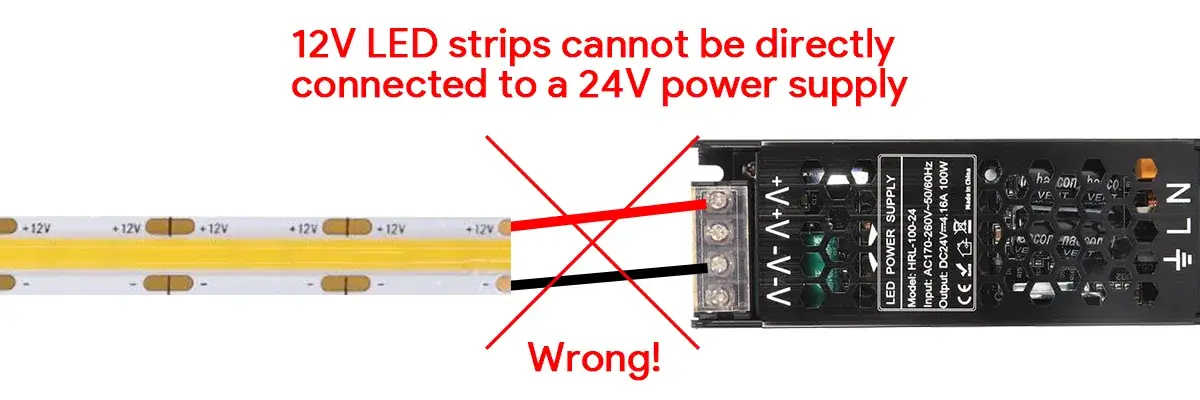
LED 照明プロジェクトでは、12V と 24V が最も一般的な 2 つの低電圧規格です。 とはい 12Vおよび24V LEDストリップ 構造が似ているように見えますが、それらの内部回路設計、抵抗分布、および電流を運ぶ容量はまったく異なります。 12V ストリップを 24V 電源に接続すると、電圧過負荷が直接発生し、次の重大な結果が生じます。
過電圧の結果
12V ストリップは 12V の電圧で動作します。24V DC 電源に接続すると、定格電圧の 2 倍になり、その制限を超えます。 一般的な問題は次のとおりです。
- LED チップの即時焼損: LED チップは 12V 電流で動作するように設計されています。 24V に接続すると、電流が 2 倍になり、過熱が発生し、LED チップの焼損や変色の原因となります。
- 抵抗過熱損傷: LED ストリップの直列接続電流制限抵抗がひどく過熱し、抵抗器の故障、PCB の変形、さらには煙や火災の危険があります。
- 全体の光のストリップが使用できなくなりました: 回路が損傷すると、修理費用は、特に取り付けが困難な設置シナリオでは、ライト ストリップ全体を交換するコストを上回ります。
LED バーンアウトの背後にある原理の分析
LED は基本的に電流駆動デバイスであり、電圧の変化により電流が急速に上昇する可能性があります。 通常、12V ライト ストリップは、一連の 3 つの LED と、次に並列に接続された一連の LED で構成され、電流制限抵抗を使用して一定の明るさを維持します。 24V に接続すると、制御されていない電流により次の現象が発生します。
- シリーズ接続 LED は電流共有保護を失います: 1 つの LED が燃え尽きると、グループ全体が機能しなくなり、ライト ストリップ全体に影響を与えます。
- 抵抗が過熱し、基板表面が炭化する原因となります。
- 正の端子過電圧ブレークダウンにより、回路が短絡します。
現場での使用リスクは、実験室の設定よりも大幅に高くなります
実験室環境では、24 V に短時間接続してもすぐにライト ストリップが焼き尽くされない場合でも、次のエンジニアリング シナリオではリスクが大幅に増加します。
- 一括並列インストール: 電力負荷が増加し、セクションが失敗すると、燃え尽き症候群の連鎖反応を簡単に引き起こす可能性があります。
- 屋外または密閉 アルミチャンネル 環境: 放熱が悪く、熱暴走につながります。
- ライトストリップの隠しインストール: バーンアウトが遅く検出され、高いメンテナンス コストが発生します。
電圧の不一致は「小さな問題」ではありませんが、軽いストリップの寿命、安全性、およびプロジェクトの配信タイムラインに深刻な影響を与える深刻な危険です。 信頼性を優先する商用照明プロジェクトの場合、12V の光ストリップが 24V 電源に接続されないようにすることは、最も基本的な電気設計基準の 1 つです。
24V 電源で 12V LED ストリップ ライトを安全に動作させることはできますか?
技術的には、そうです。できますが、直列に正しく接続する場合に限ります。
正しい電圧に指定された製品やアクセサリを使用することを強くお勧めしますが、12V LED ストリップ ライトを A に接続する方法を示します。 24V電源 LED ストリップ ライトを損傷することなく!
免責事項: 過電圧の原因となる不正確または偶発的な接続により、LED が永久に損傷する可能性があります。 ここに記載されている情報は、教育目的のみを目的としています。 SignLiteLed は、いかなる損害についても責任を負いません。
安全上の理由から、同じ 12V LED ストリップの 2 つの短いセクションでテストして、より長いセクションを接続する前にすべてが正しくセットアップされていることを確認することをお勧めします。
正しい配線方法: 直列接続
理論的には、2 つの同一の 12V LED ライト ストリップを直列に接続すると、合計電圧 24V になり、24V システムと互換性があります。 このように LED 光ストリップを接続することにより、24V の電源が 2 つの LED ライト ストリップ セグメント間で効果的に「分割」され、各セグメントは 12V になります。2 つの LED ライト ストリップが直列に接続されているため、各 LED ライト ストリップは同じ電流を消費します。 具体的な接続方法については、下の図を参照してください。

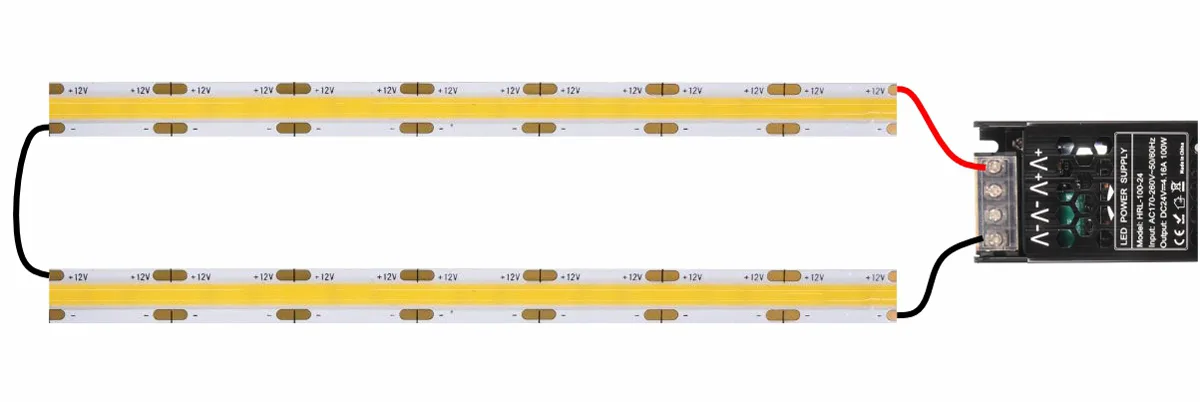
警告: 直列に接続された 2 つの LED ライト ストリップはまったく同じである必要があります。
なぜこれが重要なのですか?
長さの異なる 12V LED ライト ストリップが 2 つ直列に接続されているとします。 12V の電圧では、それぞれ 0.5A と 1.0A の電流を消費します。 直列に接続されているため、同じ順方向電流値を共有する必要があります。 現在の値が正確に 0.75A (中間点) であるとします。
より長い LED ライト ストリップの場合、(定格 1.0A ではなく) 0.75A の低い電流に合わせるために、電圧は 11V または 10V まで低下する必要があります。ただし、24V の定電圧入力は、24V で一定のままであるため、残りの 13V または 14V 電圧を「構成」する必要があります。 これにより、短い LED ライト ストリップが過電流状態になり、LED が損傷する可能性があります。
シリーズ構成でのみ、12V LED ライト ストリップを 24V 電源で動作させることができます。 このテクノロジーはスマートでスケーラブルで、教育や設置目的に非常に役立ちますが、実際のエンジニアリング プロジェクトのインストールでは、重大なリスクをもたらす可能性があります。
- 同じストリップ長とタイプを使用する必要があります。
- 電圧分布が不均一になる場合があります。
- あるストリップの障害は、別のストリップに影響を与える可能性があります。
抵抗の変化、はんだ付けの不安定さ、またはストリップの老化が不均一になると、電圧分布が不均一になり、損傷のリスクが高まる可能性があります。 したがって、この方法は緊急時にのみ使用することをお勧めします。
LED ストリップ ライトを電源に接続する方法の詳細については、ブログの投稿をお読みください。 LEDストリップライトの電源配線の究極ガイド そして LEDストリップライトを電源に接続する方法.
より優れた技術的ソリューション: 24V システムで 12V LED ストリップ ライトを使用する方法
一部のプロジェクト サイトでは、24V の電源システムが一様に展開されています。 ただし、在庫の問題、アウトソーシング、または後期の要件の変更により、12V LED ストリップ ライトを一時的に使用する必要がある場合があります。 LED ストリップ ライト自体を交換できない場合、24V 電源システムに安全に接続する方法はありますか? 答えはイエスですが、システムの安定性と安全な動作を確保するために、専門の電圧削減方法を使用して行う必要があります。
解決策 1: DC-DC 降圧コンバータを使用する
これが最も一般的で最も安全な方法です。 電源出力と LED ストリップの間に DC-DC 降圧コンバータを挿入することにより、24V の電圧が 12V 出力に確実に変換され、LED ストリップが正常に動作するようになります。
利点がある:
- 12V 出力は、すべての 12V LED ストリップ モデルと互換性があります。
- 複数のモジュールを並列に接続して、セグメント化された電源を使用して配線を容易にすることができます。
- システムの安定性を高めるために、過電圧保護と過負荷保護を備えた産業用モジュールが利用できます。
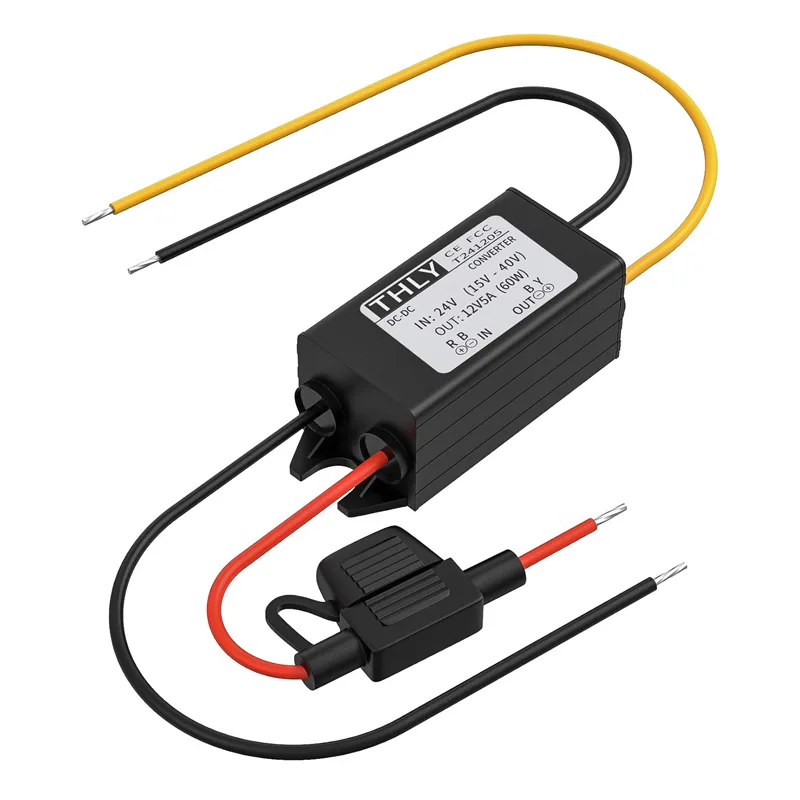
DC24V-12V 降圧コンバータ
出力電圧DC12V
最大電流: 5A 60W
効率: 96%
防水:IP67
製品寸法: L114 x W79 x H20 mm
正味重量: 264g
アプリケーションのシナリオ:
- ショッピング モールのディスプレイ ケースと窓の照明。
- 展示や展示の調整可能な照明。
- セグメント制御を備えた室内照明システム。
推奨される考慮事項:
- モジュールの電源は、光ストリップの総消費電力に対応している必要があります。20%-30% マージンを残すことをお勧めします。
- 短絡保護機能と電圧安定化機能を備えた製品をお勧めします。
- 設置中の放熱と防水に注意してください (屋外プロジェクトに使用する場合)。
解決策 2: デュアル電源システム構成 (絶縁電源)
中規模から大規模なプロジェクトでは、24V の主電源が 24V 機器を駆動し、12V の光ストリップに追加の 12V 電源を追加するデュアル電源システムを採用することもできます。
利点がある:
- メンテナンスを容易にするための各システムの独立した制御。
- 電源の干渉に敏感なハイエンド プロジェクトにより適しています。
- DMX や DALI などのインテリジェント制御システムと組み合わせて展開できます。
適用可能なシナリオ:
- ホテル、商業施設、博物館などのマルチシステム照明プロジェクト。
- プロジェクトの実装時に 12V モジュールを追加する場合の統合が容易になります。
注意:
- 2 つの電源グループは共通のグランドを共有してはならず、完全に分離されている必要があります。
- 実装中の配線エラーを防ぐために、回路の明確なラベル付けが必要です。
- 制御システムは、電圧セグメントに従ってグループ化する必要があります。
ソリューション 3: 集中型電源 + モジュラー出力設計 (統合システムに適しています)
分散照明制御システム (大規模なインテリジェント照明プラットフォームなど) の場合、集中型電源キャビネットを使用して 24V の電力を均一に入力し、モジュラー出力ボードを介して 12V 信号に変換できます。
利点がある:
- 集中管理とモジュラー インストール。
- 産業用照明およびインテリジェントな建物制御システムに適しています。
- メンテナンス コストを削減し、障害の診断を容易にします。
デメリット
- 初期展開コストの増加。
- 建設配線の特定の要件。
推奨されないソリューション: 直列接続されたライト ストリップ、抵抗電圧の低減など
回路理論の観点からは、直列抵抗または複数の直列接続を追加することで電圧を下げることができます。また、このソリューションの接続と原理についても詳しく説明しましたが、これらの方法は、実際の照明プロジェクトで高い故障率と安全上の危険をもたらします。
- 直列接続された LED ライト ストリップは、コンポーネントの均一性に大きく影響します。
- 抵抗の電圧低減方法は非効率で、過熱を発生します。
- ソリューションには保護機構がなく、電圧変動によって機器が損傷しやすくなります。
したがって、プロのプロジェクトでは、標準化された電圧低減モジュールまたは安定した出力と保護機能を備えたグループ化された電源システムを選択することが不可欠です。
12V ライト ストリップが 24V システムと互換性がないという問題に対する解決策は存在しますが、適切な計画と標準化された選択が必要です。 プロジェクト規模、設置環境、および制御システムに応じて、適切な電圧削減方法を選択することで、改修コストを削減し、長期的に安定したシステム運用を保証できます。
代替推奨事項: 互換性のある電圧を持つ LED ストリップ製品を選択してください
ステップダウン ソリューションにより、12V LED ストリップを 24V システムと互換性を保つことができますが、プロジェクトの安全性、安定性、およびメンテナンス コストの観点から、選択することをお勧めします。 LED ストリップ製品 プロジェクトの最初からシステムに互換性のある電圧を使用します。 この戦略により、エンジニアリングの失敗率を効果的に減らし、システム全体の効率を改善し、寿命を延ばすことができます。
したがって、プロジェクトに基づいて正しいソリューションを選択する必要があります。 24V システムで 12V LED ライト ストリップを使用するかどうかを決定するときは、次のことを自問してください。
- これは一時的または恒久的な設定ですか?
- 降圧コンバータまたは追加の電源を使用できますか?
- 安全に直列に接続できますか?
- 24V の電源装置へのアップグレードは、長期的にはより効率的でしょうか?
最も実用的なソリューションは、24V LED ライト ストリップにアップグレードすることです。 システムがすでに 24 V で標準化されている場合、アップグレードにより、インストールと電源管理が簡単になります。 なぜ 12V より 24V が好まれるのですか? 12V システムと比較して、24V LED ライト ストリップは、中距離から長距離の設置で大きな利点を提供します。
- 低電圧損失: 同じ電流条件下で、24V システムのライン損失は 12V システムの半分であり、長距離配線により適しています。
- ユニットあたりの電流が減り、システムの安全性を高める: ケーブルの過熱や短絡のリスクを軽減します。
- より長い単一セグメントにすることができます: 過度のスプライシング ポイントを回避し、光効率の一貫性を向上させます。
- DALI や DMX などのスマート照明システムとの互換性が向上: 集中電源とデジタル調光を実現しやすくなります。
したがって、プロジェクトがすでに 24V 電源システムである場合、24V ライト ストリップを選択することが最も信頼できるオプションです。
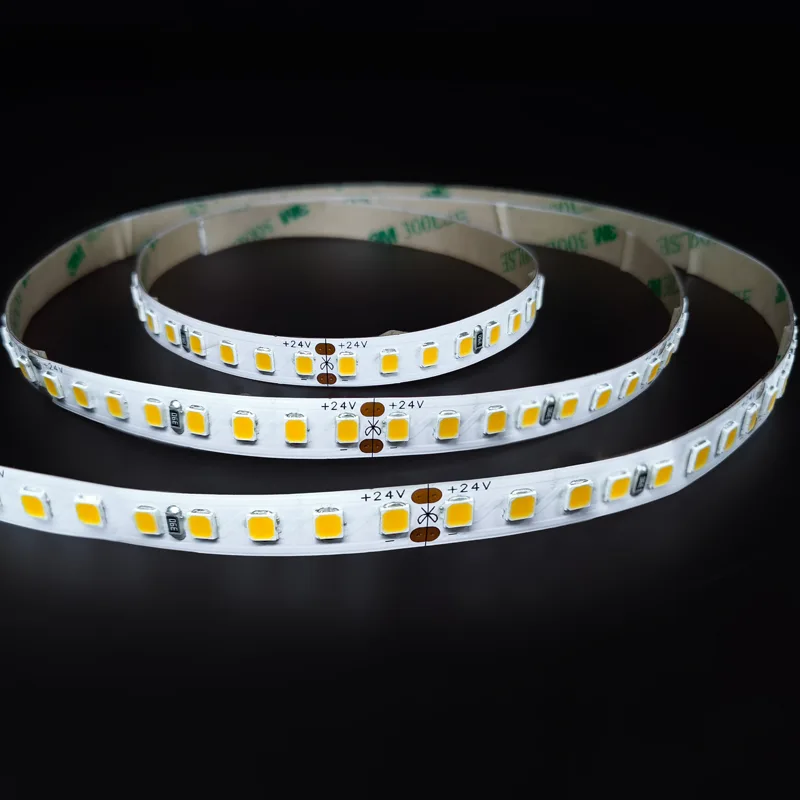
高効率 DC24V LED ストリップ ライト
モデル番号 FQX10T128C
電圧: DC24V
パワーだ: 12W/m
効率: 190-200lm/W
ラーだ: >80
CCTだ: 3000k – 6500k
LEDタイプ: SMD2835
LED QTY: 128LEDs/m
PCB幅: 10mm
切断ユニット: 62.5mm/8LED
IP等級: IP20/IP54/IP65/IP67/IP68
保証: 5年
選択の推奨事項: プロジェクトに適した電圧 LED ストリップを選択してください
| プロジェクト・タイプ | 推奨電圧 | 推論 |
| 商業スペースのシーリング ライト トラフ | 24V | 設置距離が長い、一元的な電源、最小のライン損失 |
| ディスプレイ キャビネットまたは窓の照明 | 12V/24V | ライト ストリップの長さと電源の位置によって異なります |
| スマートビルディング調光システム | 24V | DALI および DMX コントローラとの互換性が向上 |
| 家具の照明をカスタマイズ | 12V | 分散電源、さまざまな長さの光ストリップ、フレキシブル配線 |
| 屋外防水ライト ストリップ システム | 24V | 高出力ドライバの安定性が向上し、耐電圧が高くなります |
正しい電圧を選択することは、プロジェクトの成功を判断するための最初のステップです。 建設の後半の段階で修正を加えるよりも、最初の選択段階でシステムの互換性、回路設計、および製品の性能を十分に考慮して、1 回限りの設置と長期的な安定性を確保することをお勧めします。 実際のプロジェクトの実施では、エンジニアリングの経験があるサプライヤーと協力して、電圧、電流要件、制御方法、および設置環境に基づいてシステムをカスタマイズすることをお勧めします。
24V または 12V LED ストリップの選択についてまだ質問がある場合、SignLiteLED は次のサポートを提供できます。
- エンジニアリング電源と LED ストリップ システム マッチング デザイン。
- DC-DC 降圧モジュールと集中型電源ソリューション。
- さまざまな商用プロジェクトに適した、大量供給および OEM カスタマイズ サービス。
お願い お問い合わせ プロジェクトの評価と専門家のアドバイス。
概要: 12V/24V システムの不一致に伴うリスクを軽減する方法
商業用照明およびエンジニアリング プロジェクトでは、LED ストリップ照明システムの安定した動作は、製品自体の品質だけでなく、電源システムの合理性と設置基準への準拠にも依存します。 この記事では、12V LED ストリップを 24V 電源に直接接続する複数のソリューションと技術的分析を通じて、ストリップ損傷やプロジェクトの再作業に簡単につながるリスクの高い方法を特定します。
プロジェクトの要件や在庫の制約により、24V システムで 12V ストリップを使用する必要がある場合は、機器の安全性と寿命を確保するための移行手段として、プロフェッショナルな電圧削減モジュールまたは絶縁型の電源システムを選択する必要があります。
長期的な観点から、プロジェクトの最初から電源システムの電圧に一致する LED ストリップ製品を選択することは、エンジニアリングの複雑さを軽減し、インストール後のメンテナンスを最小限に抑えるための最適な戦略です。
LED ストリップ ライト プロジェクトの電気規格の推奨リスト
| プロジェクトフェーズ | 推奨事項 |
| 回路図設計段階 | 複数の電圧の混合を避けるため、システムの供給電圧 (12V または 24V) を指定してください |
| 軽いストリップ製品の選択 | システムと互換性のある電圧バージョンを優先する、たとえば 24V システムの 24V 照明ストリップ |
| 現場配線の設置 | 12V 照明ストリップを 24V 電源に直接接続することは固く禁じます。DC-DC 降圧モジュールまたは絶縁電源装置を使用する必要があります。 |
| 電源装置の調達 | 短絡、過電圧、過熱保護機能を備えた電源装置と降圧モジュールを選択してください |
| 軽いストリップの設置テスト | 完全な電源投入後の障害を防ぐために、各セクションを取り付ける前にセグメント化された照明テストを実施します。 |
| プロジェクトの配達と受け入れ | 電源と光のストリップ モデルが一致することを確認し、電源装置の図と光のストリップの配線計画を文書化します。 |
プロジェクトでクロス電圧互換性ソリューション、集中型電源設計、またはカスタム モジュールが必要な場合は、SignLite のチームに連絡してください。 総合的に提供しています LEDストリップ照明 プロジェクトの効率的な配信と安定した運用を実現するためのシステム設計サポート。
よくあるご質問
これを行うことはお勧めしません。 短期間で燃え尽きなくても、光の帯の寿命が大幅に短縮され、安全上の問題を引き起こす可能性があります。 軽いビーズの中には、高温でわずかな変色や明るさの劣化が生じることがあり、そのリスクを制御するのは困難です。
これはお勧めしません。 電圧共有は理論上は可能ですが、一貫性のないインピーダンスと抵抗は、最初に 1 つのセクションが焼き尽くされ、もう一方のセクションが保護されず、連鎖反応を引き起こします。
1. 出力電力が LED ストリップの総消費電力に合致し、余裕を確保できるようにします。
2です 。 モジュールには、短絡、過電圧、過熱保護機能が必要です。
3. 屋外または高温環境では、放熱または防水対策を強化します。
デュアル電源システムまたは集中型電源 + モジュラー出力構成を使用できます。 重要なのは、異なる電圧システム間の物理的な分離、配線の明確化、独立した制御、および図面の明確なラベル付けを確保することです。
ライト ストリップ ラベル、電源インターフェイス ラベルを確認するか、マルチメータを使用して動作電圧を測定します。 異なる電圧の混合による誤接続を避けるために、工事前に軽いストリップ電圧バッチを管理することをお勧めします。
